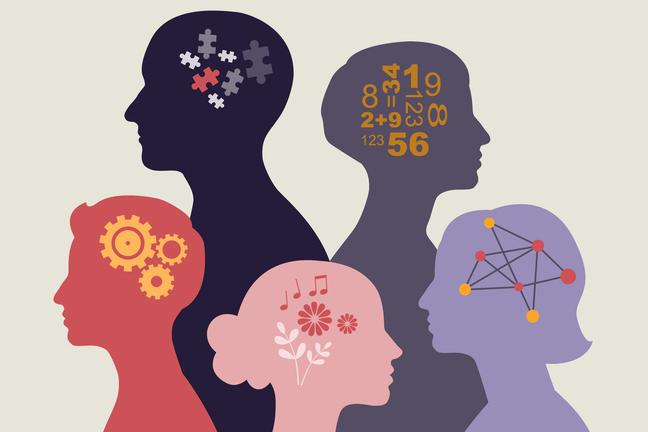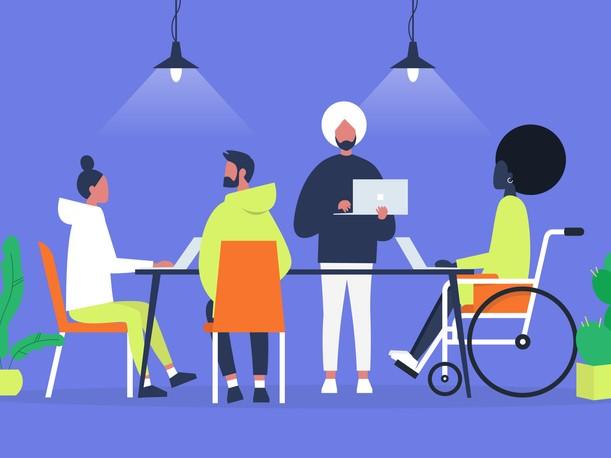Neurodiversity typically recognises the natural expanse of human differences and the diversity of the human brain. The more clinical view is that neurodiversity encompasses individuals with dyspraxia, dyslexia, attention deficit hyperactivity disorder (ADHD), dyscalculia, autistic spectrum and Tourette’s syndrome. A social view of neurodiversity separates the difference in the brain and thinking (impairment) from how the individual interacts with, or the barriers in, their environment (disability). For example, a person with dyslexia may read with a different part of their brain. The accessibility of materials and accommodations provided, from a student’s application and enrolment to the materials used in courses, will impact how “disabled” that individual is on campus and in the classroom.
Neurodivergent people are not a monolith, and we must consider that there will be times that the best ways to ensure inclusion and access for one person may not be the best for another. For instance, we recognise the various views of the neurodivergent community, such as a preference for the use of person-first language (using terms such as “person with a disability”) or identity-first language (“disabled person”). Being flexible and accommodating to the varied student needs on campus shows recognition and support for diverse communities. By implementing accessible resources and supports such as alternative learning spaces, sensory spaces, comprehensive mental health support and accessible modalities to learning, universities can support neurodivergent students to succeed.
- How can we create accessible and inclusive learning environments for neurodivergent students?
- Changing instructor behaviour to improve learning for university students with ADHD
- Get real about hiring people with disabilities
A neurodivergent-inclusive campus promotes understanding of neurodivergence and neurodivergent perspectives and celebrates differences and different ways of thinking. University leadership, faculty and staff can take steps to build an inclusive campus for neurodivergent students that also benefits all students on campus.
Understand neurodivergence from multiple perspectives
All too often, leadership, faculty and staff lack understanding about neurodivergence. The result is that neurodiverse college students can experience barriers to the implementation of accommodations as well as biases and misconceptions about neurodiversity. This can lead to misunderstandings and biases against the neurodiverse student population. For example, neurodivergent college students have expressed frustration with their instructors’ lack of understanding of neurodivergence.
Ensuring accessibility on university campuses involves fostering a deep understanding of neurodivergence and the perspectives of neurodivergent students among leadership, faculty and staff. Providing professional learning opportunities to leadership, faculty and staff is a key step in this process. A series of lectures on neurodivergence that leads to a certificate, for example, could be one way of fostering understanding and knowledge development.
Listen to and engage neurodivergent students and staff
Actively engaging neurodivergent students and staff in conversations about neurodivergence is a critical part of creating an inclusive campus. Lack of understanding of the needs and experiences of neurodiverse individuals can result in unintentionally limited access and inclusion and send a message that neurodivergent staff and students are unwelcome or even unwanted. Faculty should avoid making assumptions about the neurodiverse community. Dismissing their perspectives and experiences can perpetuate stereotypes and stigmas.
By listening to and engaging with the neurodivergent community, we can gain insight into the barriers this community faces and respond to their needs to promote equity and access. Universities can use feedback from the neurodivergent community to create goals and action steps for increasing inclusivity. Allocating personnel and resources to enacting action steps to realise the goals shows the institution’s commitment to realising these aims. When decision-makers take into account neurodivergent voices, it fosters a sense of belonging and creates a campus where all feel valued, respected and welcomed.
Provide university-wide training to all faculty
Universal design for learning (UDL) is an approach that offers pathways and engagement opportunities for all students in their courses. If UDL is understood and applied across all majors and content areas, the campus itself becomes more inclusive.
College campuses are diverse environments with a wide range of students, each with their own backgrounds, abilities, needs and goals. To support the diversity of the campus, faculty and staff need to be provided with professional development in UDL to produce inclusive, equitable and effective learning environments that support the success of all students.
By embracing UDL principles, universities can effectively accommodate varying learning styles, preferences and abilities, fostering an environment where students can thrive academically and contribute meaningfully to the campus community.
This commitment to support a neurodivergent-inclusive campus enriches the educational experience and provides a more equitable and supportive environment for everyone.
Meghan Cosier is associate professor and executive director of the Thompson Policy Institute on Disability, and Audri Sandoval Gomez is director of the Thompson Policy Institute on Disability, both in the Attallah College of Educational Studies at Chapman University.
If you would like advice and insight from academics and university staff delivered direct to your inbox each week, sign up for the Campus newsletter.




comment